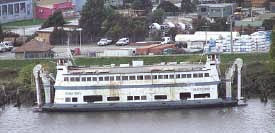The first European to make a permanent home on Bruny Island was James Kelly, the Hobart Harbor pilot. James Kelly made his mark on history by being the first man to circumnavigate Tasmania in an open whale boat. He is also remembered by history for the discovery of Macquarie Harbour. Like many others at the time Kelly made his fortune in "Bay Whaling" from the camps on the shores of Bruny Island.
James Kelly built his home on the North West tip of Bruny Island and the location was called Kelly's Point. Now it is called Dennes Point after the Dennes family who bought James Kelly's properties on Bruny Island. The first ferry jetty on Bruny Island was built on Kelly's Point and was a regular stopping place for Channel ferries and other vessels.
From the 1820's ketches ferried goods and people between Bruny Island and Hobart. Small rough jetties were made in sheltered bays or people simply rowed up onto the many sandy beaches along Bruny's shores.
As land was cleared and agriculture thrived on Bruny and up the Huon river and new breed of boat men grew. Sailing ketches ferried produce, people, mail and hardware to Bruny as well as up the Channel and to the Huon River settlements
By the 1850's Bruny Island was well settled. Whaling and small cropping had given way to large sheep farms such as Murryfield. These changes brought affluence and culture to Bruny Island. Regular horse races were held on the Bruny Island race track on Murryfield and people were brought down by ferry from Hobart for a weekend at the Bruny Island races. By this time steamer driven ferries were completing with the sailing ketches for the Bruny Island ferry business. Soon the sailing ketch would be relegated to history and a new era would begin... the era of steam.
Whilst most of the ferry traffic to Bruny Island came from Hobart there were also some locally operated ferry services between Bruny Island and other population centres in the D'Entrecasteaux Channel.
One of these was a very small affair. The ferry operating from Three Hut Point at Gordon to Sheepwash Bay on South Bruny was a 3 metre boat driven by sail and oar. The ferryman was one George Davis who rowed the couple of miles carrying passengers between the three pubs at Gordon and their homes on South Bruny.
When George Davis retired the Gordon to Bruny ferry service was taken over by Teddy Spong who also carried the mail across to South Bruny twice a week in his little ferry. Its is said that Teddy Spong only missed one crossing of the Channel in two years and that was because such a gale was blowing up the Channel that local residents chained up his boat to prevent him making the crossing in such dangerous conditions
Since 1954 there have been four different vehicular ferries operating from Bruny Island
The first full time vehicle ferry to Bruny Island was the S.S. Melba which ran between Kettering and Barnes Bay from 1954 to1961. After she was retired from the Bruny run she often worked as a replacement ferry if the others needed to be repaired.
Next was the Mangana which ran to Barnes Bay from 1961 until 1983.
In 1983 the Mangana was replaced by the Harry O'May . The replacement of the Mangana co-incided with a change in the ferry route to Bruny Island. A new landing platform was constructed at Roberts Point on Bruny and the shorter route cut the time of the ferry trip from Kettering to Bruny by more than half.
The Harry O'May continued ferrying cars and passengers to Bruny Island until 1991.
In 1991 the current Bruny Island ferry, the Mirambeena took over as Bruny Island's ferry and has been doing a fantastic job every since.
Text, Information & vintage photos sourced from the
Bruny Island Ferry History Archive
Bruny Island Ferry History Archive










